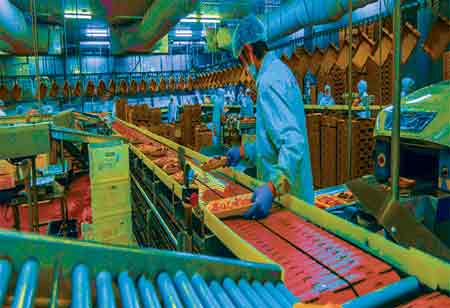THANK YOU FOR SUBSCRIBING
Be first to read the latest tech news, Industry Leader's Insights, and CIO interviews of medium and large enterprises exclusively from Food and Beverage Tech Review
Improving Efficiency of Food Manufacturing Through Automation
Automation in food processing is revolutionizing the landscape of food manufacturing, ushering in a new era of efficiency

By
Food and Beverages Tech Review | Monday, January 29, 2024
Stay ahead of the industry with exclusive feature stories on the top companies, expert insights and the latest news delivered straight to your inbox. Subscribe today.
The critical driver of automation in food processing is the need for increased efficiency.
FREMONT, CA: Automation in food processing is revolutionizing the landscape of food manufacturing, ushering in a new era of efficiency, quality, and sustainability. Traditional food manufacturing methods often involve manual labor, a labor-intensive process prone to errors and time-consuming. Automation streamlines production processes using robotics, AI, and advanced machinery. It reduces production time and ensures consistency in product quality. The food processing sector will likely see further innovations, contributing to a safer, more efficient, and more environmentally friendly global food supply.
Automating systems with sensors and cameras can assess crop health and ripeness in harvesting and agriculture, enabling precise and timely harvesting. It optimizes yields and minimizes waste by harvesting only the ready crops. Automated harvesting can particularly benefit delicate fruits and vegetables, where human handling may lead to bruising and damage. Automation is applied to processing facilities' sorting, cutting, and cooking tasks. Robotic arms with computer vision capabilities can accurately sort and handle products, improving efficiency and maintaining product integrity. Automated systems contribute to sustainability goals.
Automated cooking processes can be precisely controlled to ensure consistency in taste and texture, meeting the stringent quality standards demanded by consumers. Quality control is another area where automation plays a pivotal role. Advanced sensors and imaging technologies can detect imperfections, contaminants, and irregularities in real time, ensuring high-quality products for consumers. It enhances food safety and reduces the likelihood of recalls, protecting consumers and manufacturers. The environmental impact of food manufacturing is also positively influenced by automation.
Adopting automation in food processing also contributes to enhanced safety and hygiene. Automated systems minimize the need for human intervention in potentially hazardous environments, minimizing the risk of accidents and contamination. It is crucial in industries with stringent hygiene standards, such as meat processing and dairy production. Automation facilitates traceability in the food supply chain. Transparency helps identify and address potential issues and strengthens consumer confidence by providing information about the origin and production process of the food they consume. Automation is transforming the future of food manufacturing by enhancing efficiency, ensuring quality, and promoting sustainability.
Energy-efficient technologies and using renewable energy sources in automated facilities reduce the overall carbon footprint of food production. Adopting automation in food processing presents challenges. Initial implementation costs can be substantial, and there may be concerns about job displacement in specific industries. It's essential to recognize that automation often creates new, high-skilled jobs in areas such as programming, maintenance, and system supervision. Integrating robotics, artificial intelligence, and advanced machinery across the food supply chain reshapes traditional processes and drives the industry toward a more technologically advanced and sustainable future.
I agree We use cookies on this website to enhance your user experience. By clicking any link on this page you are giving your consent for us to set cookies. More info







